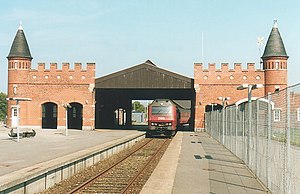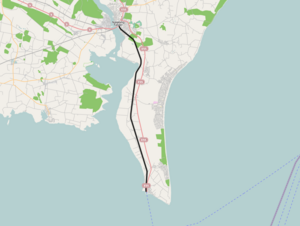Nykøbing – Gedser railway line
| Nykøbing – Gedser | |||||||||||||||||||||||||||||||||||||||||||||
|---|---|---|---|---|---|---|---|---|---|---|---|---|---|---|---|---|---|---|---|---|---|---|---|---|---|---|---|---|---|---|---|---|---|---|---|---|---|---|---|---|---|---|---|---|---|
|
Gedser train station
| |||||||||||||||||||||||||||||||||||||||||||||
|
Nykøbing – Gedser line
| |||||||||||||||||||||||||||||||||||||||||||||
| Route number : | 3 | ||||||||||||||||||||||||||||||||||||||||||||
| Route length: | 23 km | ||||||||||||||||||||||||||||||||||||||||||||
| Gauge : | 1435 mm ( standard gauge ) | ||||||||||||||||||||||||||||||||||||||||||||
| Top speed: | 75 km / h | ||||||||||||||||||||||||||||||||||||||||||||
|
|||||||||||||||||||||||||||||||||||||||||||||
The Nykøbing – Gedser railway is a single-track railway line in Denmark . It is located on the island of Falster and has been connecting Nykøbing with Gedser since 1886. The route had been closed since 2009, but was available until September 1, 2017 with route number 2 in the Banedanmark documents that were valid until then . After a PU signal (PU = Peronudkørselsignal - platform exit signal), the monitored area within the former Væggerløse station ended at an unsecured level crossing. The signal systems are out of order. The route is no longer listed in the documents after September 1, 2017.
history
After Nykøbing Falster had a railway connection with the Nykøbing – Orehoved line in 1872 , A / S Gjedser Jernbane built the Nykøbing – Gedser line as a private railway and put it into operation on July 1, 1886.
This enabled the mail steamer connection from Warnemünde to Nykøbing to be shortened to the Warnemünde – Gedser route. Together with other railway lines, the Nykøbing – Gedser connection was nationalized on January 1, 1893 and taken over by the Danske Statsbaner . With the opening of the Warnemünde – Gedser ferry connection on October 1, 1903, international long-distance traffic came to this route. After the Second World War , the traffic situation fundamentally changed due to the Iron Curtain . Since 1949 the Warnemünde – Gedser ferry connection has been operated by the DSB together with the Deutsche Reichsbahn . Since this connection could not be used by the German Federal Railroad , they set up the train ferry Großenbrode-Gedser in 1951 .
International long-distance traffic developed very well on this connection, with more and more long-distance trains running on the Nykøbing – Gedser route. This long-distance service ended in 1963 when the Vogelfluglinie opened and operations on the Großenbrode – Gedser ferry connection were discontinued. After operations by the Deutsche Reichsbahn had declined to a weekly pair of passenger trains from 1954, there was again a daily direct connection between Berlin and Copenhagen since 1957 . From 1963 to 1970, the DR class VT 18.16 express railcars were used for this purpose.
The connection experienced a brief boom after the fall of the inner-German border in 1989. In 1995, the rail ferry service between Warnemünde and Gedser was discontinued. Since then there has been at times no train service between Nykøbing and Gedser. In December 2009 the traffic was completely stopped. Last day, a pair of trains ran on the route. The route should be expanded, but this failed due to cost reasons.
In the course of the renovation of the ferry port, all tracks were finally removed from Gedser train station in summer 2011 and the building was redesigned as another ferry terminal. A resumption of the Berlin – Copenhagen rail connection via the Rostock – Gedser ferry is therefore no longer possible. However, the Gedser Railway Museum was connected to the existing railway line with a new track connection. In summer 2015, tourist trains ran to Gedser again for the first time.
Railway Museum
A railway museum has been set up in the former depot in Gedser since 1987 . Bevaringsforeningen Gedser Remise had rented the depot, which was no longer needed by the DSB, and kept many vehicles from other museum railways in it. On April 1, 1998, the association acquired the facility from the DSB.
With the help of German and Danish fans of the Olsenbande film series , the well-known signal box "Det Gule Palæ" from the film " The Olsenbande sets the course " was largely saved. It was transferred from Copenhagen to Gedser in September 2016.
literature
- Victor Freiherr von Röll : Article Danish Railways . in: Encyclopedia of Railways . Volume 3. Berlin / Vienna 1912, pp. 213-220.
- Friedhelm Ernst: The Vogelfluglinie . Freiburg 1999.
Individual evidence
- ↑ TIB SStræknings-oversigter. (PDF) Banedanmark, p. 103 , archived from the original on December 21, 2016 ; accessed on January 13, 2020 (Danish).
- ^ Article in Jyllandsposten , accessed on December 13, 2009
- ↑ Routing after the conversion of the terminal. (PDF; 499 kB) (No longer available online.) Formerly in the original ; accessed on December 13, 2016 . ( Page no longer available , search in web archives )
- ^ Gedser Remise. Retrieved December 13, 2016 (Danish).
- ^ Thomas Rasmussen: Train Ride from Nykøbing Falster to Gedser and back. In: YouTube. August 13, 2016, accessed December 13, 2016 (Danish).
- ↑ List of museum vehicles. Archived from the original on July 17, 2014 ; accessed on December 13, 2016 .
- ^ History of the railway depot. Archived from the original on July 14, 2014 ; accessed on December 13, 2016 .
- ↑ TAG24.de: save Saxony Interlocking
Web links
- Photos from the Gedser Remise railway museum . Archived from the original on February 16, 2013 ; accessed on December 13, 2016 .

